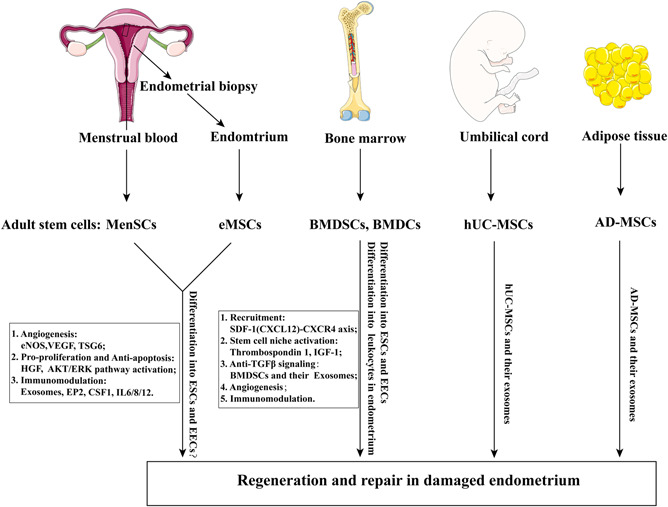Figure 2.

The roles of Adult stem cells for endometrial repair. A schematic diagram was established that how adult stem cells from endometrium, bone marrow, umbilical cord, and adipose tissue repair the damaged endometrium. MenSCs, eMSCs, BMDSCs, BMDCs, hUC‐MSCs, and AD‐MSCs act in regeneration of the damaged endometrium through direct differentiation or paracrine effects. These stem cells‐mediated paracrine factors, could participate in endometrial proliferation, angiogenesis, immunomodulation, and activate the stem cell niches to maintain stemness. There is no strong evidence that eMSCs or MenSCs differentiate into ESCs and EECs. Studies showed that BMDSCs and BMDCs can differentiate into ESCs and EECs. AD‐MSCs, adipose tissue‐derived mesenchymal stem cells; BMDCs, bone marrow‐derived cells; BMDSCs, bone marrow‐derived mesenchymal stem cells; CSF1, macrophage colony‐stimulating factor 1; EECs, endometrial epithelial cells; eMSCs, endometrial mesenchymal stem cells; eNOS, endothelial nitric oxide synthase; EP2, prostaglandin E receptor; ESCs, endometrial stromal cells; HGF, hepatocyte growth factor; hUC‐MSCs, human umbilical cord‐derived mesenchymal stem cells; IGF‐1, insulin‐like growth factor 1; MenSCs, menstrual blood‐derived stem cells; SDF‐1, stromal cell‐derived factor 1; TSG6, Tumor necrosis factor‐α‐induced protein 6; VEGF, vascular endothelial growth factor. The tissue pictures used in this figure derived from https://smart.servier.com/
